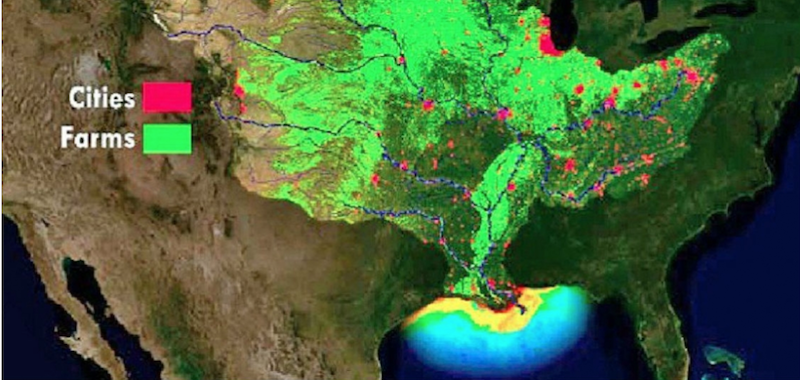The 2019 forecast is close to the record size of 8,776 square miles set in 2017 and larger than the five-year average measured size of 5,770 square miles.
The annually recurring Gulf of Mexico hypoxic zone is primarily caused by excess nutrient pollution from human activities, such as urbanization and agriculture, occurring throughout the Mississippi River watershed. Once the excess nutrients reach the Gulf they stimulate an overgrowth of algae, which eventually die, then sink and decompose in the water. The resulting low oxygen levels near the bottom are insufficient to support most marine life and have long-term impacts to living marine resources that are unable to leave the area. Considered one of the world’s largest, the Gulf of Mexico dead zone occurs every summer.
A major factor contributing to the large dead zone this year is the abnormally high amount of spring rainfall in many parts of the Mississippi River watershed, which led to record high river flows and much larger nutrient loading to the Gulf of Mexico. This past May, discharge in the Mississippi and Atchafalaya rivers was about 67% above the long-term average between 1980 and 2018. USGS estimates that this larger-than average river discharge carried 156,000 metric tons of nitrate and 25,300 metric tons of phosphorus into the Gulf of Mexico in May alone. These nitrate loads were about 18% above the long-term average, and phosphorus loads were about 49% above the long-term average.
NOAA issues a dead zone forecast each year, and refines the models offsite link used by the Hypoxia Task Force to set nutrient reduction targets and better understand the link between hypoxia and nutrients. The forecast assumes typical coastal weather conditions, but the measured dead zone size could be disrupted and its size could change by major wind events, hurricanes and tropical storms which mix ocean waters, as occurred in 2018. A NOAA-supported monitoring survey will confirm the size of the 2019 Gulf dead zone in early August, a key test of the accuracy of the models.
“The models help predict how hypoxia in the Gulf of Mexico is linked to nutrient inputs coming from throughout the Mississippi River Basin,” said Steve Thur, director of NOAA’s National Centers for Coastal Ocean Science. “This year's historic and sustained river flows will test the accuracy of these models in extreme conditions, which are likely to occur more frequently in the future according to the latest National Climate Assessment. The assessment predicts an increase in the frequency of very heavy precipitation events in the Midwest, Great Plains, and Southeast regions, which would impact nutrient input to the northern Gulf of Mexico and the size of the hypoxic zone.”
The Mississippi River/Gulf of Mexico Watershed Nutrient Task Force, a group working to reduce the Gulf dead zone through nutrient reductions within the Mississippi River watershed, has set a five-year average measured size target of 1,900 square miles.
While nutrient inputs to the Gulf of Mexico vary from year to year because of natural swings in precipitation and discharge, USGS also tracks longer-term gradual changes in nitrate and phosphorus loading into the Gulf of Mexico from the Mississippi River.
“Long-term monitoring of the country's streams and rivers by the USGS has shown that while nitrogen loading into some other coastal estuaries has been decreasing, that is not the case in the Gulf of Mexico," said Don Cline, associate director for the USGS Water Resources Mission Area. "USGS monitoring and real-time sensors, coupled with watershed modeling, will continue to improve our understanding of the causes of these changes and the role they play in the Gulf and other coastal areas.”
USGS operates more than 3,000 real-time stream gauges, 50 real-time nitrate sensors, and 35 long-term monitoring sites throughout the Mississippi-Atchafalaya watershed, which drains all rivers and streams in parts or all of 31 states and two Canadian provinces into the Gulf of Mexico.
This is the second year NOAA is producing its own independent forecast product, the culmination of a multi-year academic-federal partnership to develop a suite of NOAA-supported hypoxia forecast models. The partnership included teams of researchers at the University of Michigan, Louisiana State University, William & Mary’s Virginia Institute of Marine Science, North Carolina State University, Dalhousie University and USGS. The NOAA forecast integrates the results of these multiple independent models into a separate average forecast and is released in coordination with these external groups, some of which are also developing independent forecasts.
NOAA and its partners continue to develop additional hypoxia forecast capabilities to understand impacts on living marine resources, better evaluate the role of phosphorus on the dead zone size, and understand the relationship between hypoxia volume and area.




